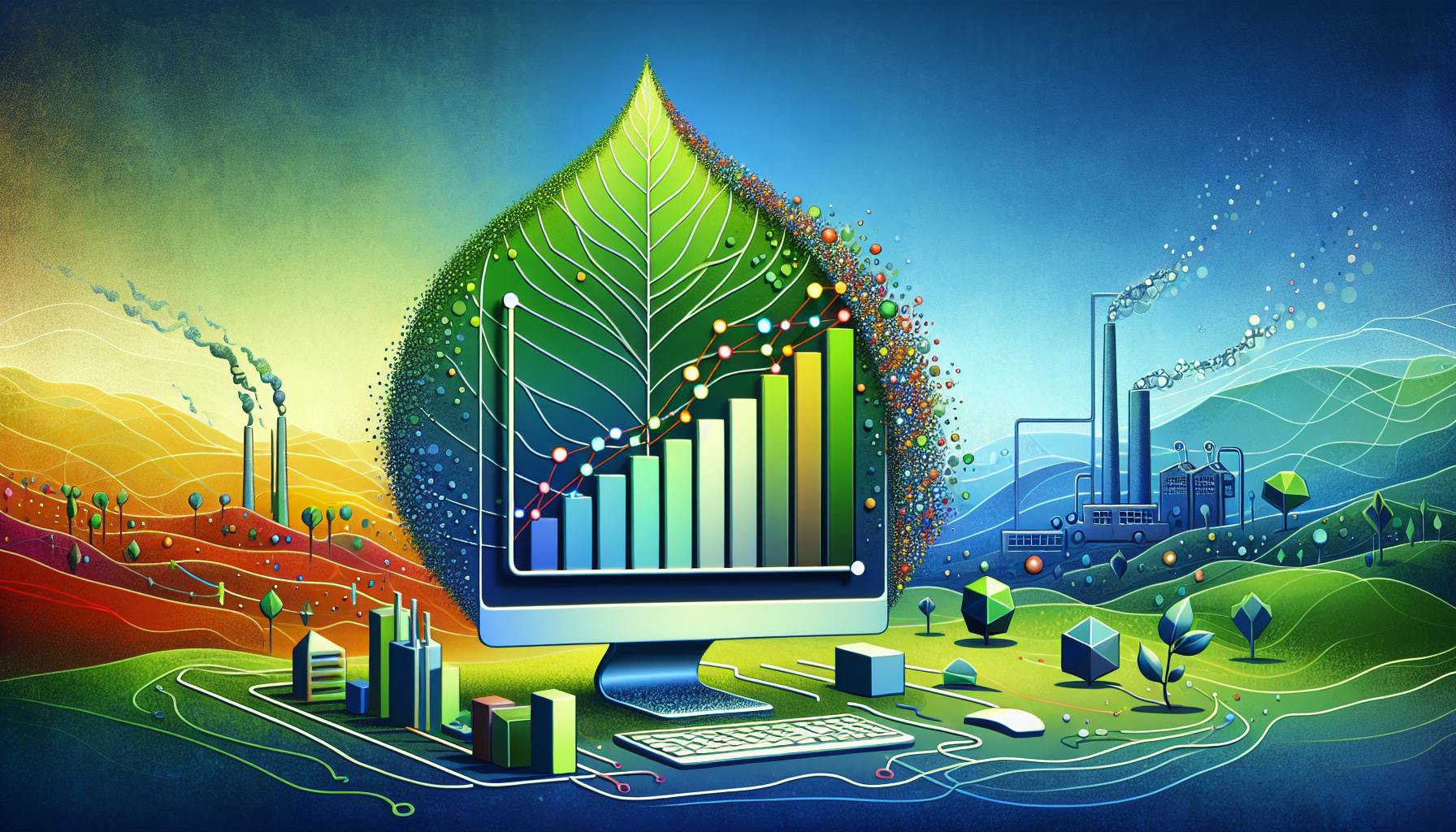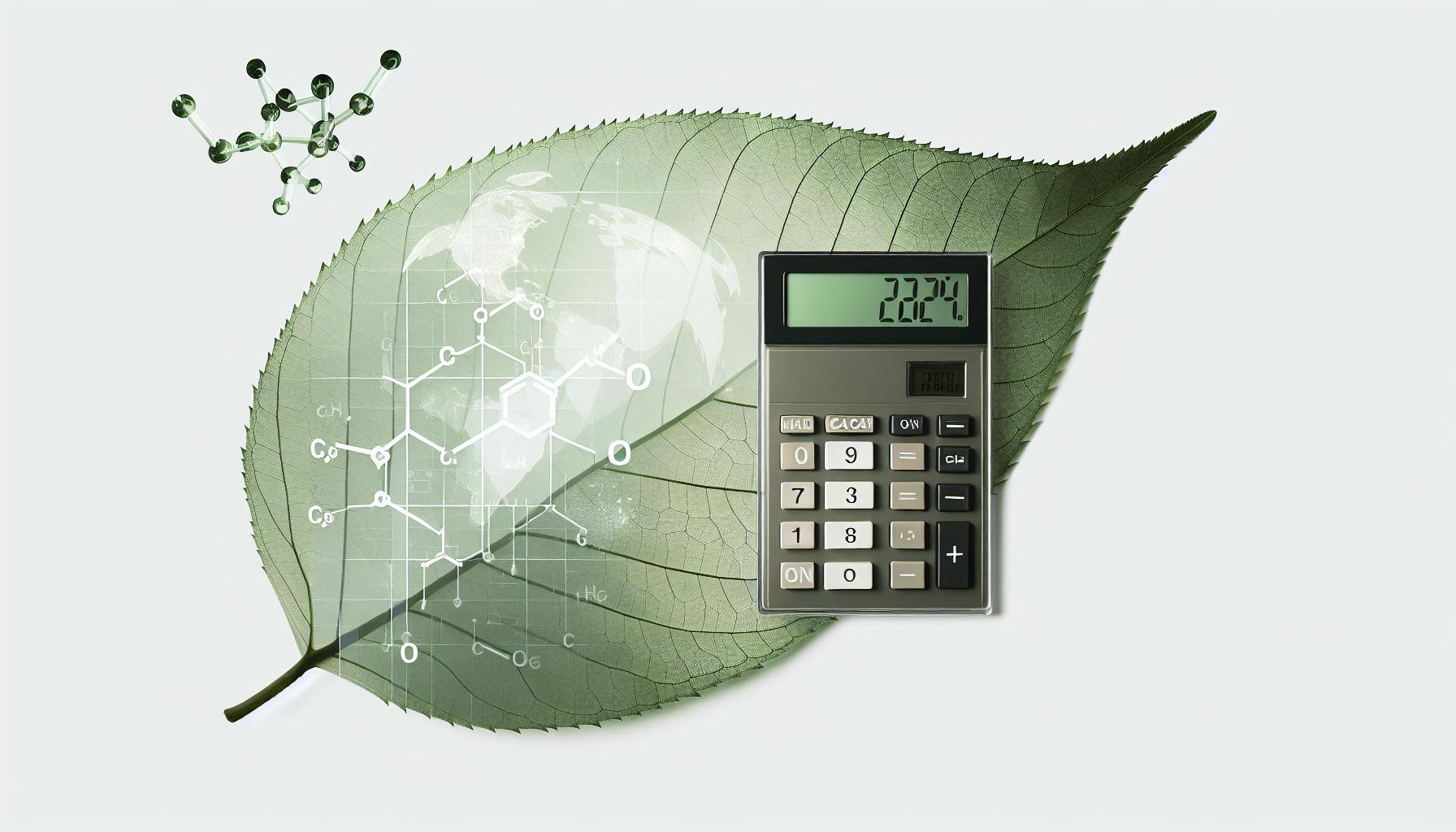Climate change represents a significant challenge, but technology offers promising solutions to mitigate its impacts and adapt to its consequences. Here's a quick overview of what you need to know:
- What is Climate Technology? Tools and methods aimed at reducing greenhouse gases, removing carbon from the atmosphere, and adapting to climate change effects.
- Key Types of Climate Technology:
- Renewable energy (solar, wind, water power)
- Energy efficiency (LED bulbs, smart devices)
- Carbon capture and storage
- Nature-based solutions (forest and wetland conservation)
- Climate-resilient infrastructure
- Sustainable agriculture
- Waste and recycling solutions
- Why It Matters: Essential for reducing emissions, complying with new regulations, creating jobs, and protecting nature.
- Areas to Watch: Renewable energy sources, energy efficiency and storage, carbon capture, sustainable transportation, smart agriculture, and waste management solutions.
- Implementing in Business: Assess your carbon footprint, choose the right climate tech solutions, and navigate integration challenges.
- The Future: Emerging trends include next-gen renewables, smarter agriculture, negative emissions technologies, climate-aware AI, advanced storage solutions, circular economy approaches, and resilient infrastructure.
- Role of Policy: Government regulations can accelerate the adoption of climate technology through carbon pricing, innovation support, and infrastructure planning.
In brief, understanding and leveraging climate technology solutions is crucial for businesses, governments, and individuals aiming to combat climate change effectively. This guide provides the foundational knowledge needed to participate in these efforts.
What is Climate Technology?
Climate technology is all about tools and methods that help us fight climate change. This includes anything that reduces harmful gases in the air, takes carbon out of the atmosphere, or helps us deal with climate change effects. It covers a big range of solutions in different areas like energy, farming, and waste management.
Some key types of climate technology are:
- Renewable energy - Think solar panels, wind turbines, and water power. These make electricity without adding bad gases to the air.
- Energy efficiency - Gadgets that use less energy, like LED bulbs, smart home devices, and electric cars.
- Carbon capture - This is about grabbing carbon dioxide (CO2) before it escapes into the air, then storing it underground or using it to make stuff.
- Nature-based solutions - Protecting and fixing up nature spots like forests and wetlands so they can soak up more carbon.
- Climate-resilient infrastructure - Making buildings and roads that can handle extreme weather better.
- Sustainable agriculture - Farming in ways that cut down on gases and store more carbon in the ground. This includes using tech to farm smarter.
- Waste and recycling solutions - Turning trash into energy or making less waste in the first place.
There are many more cool climate tech ideas out there, too.
The Evolution of Climate Tech
Climate tech isn't new—it's been around for a long time, but it's really taken off lately. Here's a quick history:
- 1970s - People start using solar panels and wind turbines more.
- 1990s - Hybrid and electric cars hit the market. Buildings and appliances get energy-saving rules.
- 2000s - We see smarter electric grids, LED lights, better batteries, and big renewable energy projects.
- 2010s - Renewable energy gets cheaper, matching the cost of old-school fuels in many places. Big projects start capturing and storing carbon, and we pay more attention to nature solutions.
- 2020s - We're mixing in digital smarts, new materials, and science to make climate tech even better. New ways to remove carbon and use hydrogen and biofuels are popping up.
Money going into climate tech has jumped from less than $10 billion to over $60 billion. As the world feels more climate change effects and governments push green policies, climate tech is becoming a big deal.
Why Climate Technology Matters
Climate tech is super important for a few big reasons:
- We need it to hit our goals for reducing bad gases in the air. Experts say we have to cut these emissions a lot, and fast, to avoid the worst climate problems.
- It helps businesses and countries follow new climate rules, like taxes on carbon and limits on emissions.
- Investing in climate tech is creating lots of jobs and could lead to big money opportunities.
- Making our stuff more durable and ready for extreme weather saves money and trouble later on.
- By cutting down on pollution from old energy sources, climate tech makes the air cleaner and helps protect nature.
In short, climate tech is key for moving towards a world where we don't add to climate change and can handle its challenges better.
Key Areas of Climate Technology
Renewable Energy Sources
Renewable energy, like energy from the sun, wind, water, and the earth's heat, is crucial for cutting down the harmful gases we create when making electricity. Here are some important ways we're doing this:
- Solar PV: Solar panels are getting better and cheaper. We're putting them on roofs, in big fields, and even on water.
- Wind power: Windmills are getting bigger and better. We're building them in the sea and coming up with new designs to make more power.
- Hydropower: We're making old dams better and using the flow of rivers to make clean electricity without hurting the environment.
- Geothermal: We're getting better at pulling heat from deep in the earth to make constant, clean energy.
Energy Efficiency and Storage
Making things use less energy and storing energy for later is key to using less and wasting less:
-
Building efficiency: New materials and smart technology in buildings, like better heating and cooling, lights, and appliances, really cut down on energy use.
-
Grid flexibility: Using smart meters and data to make sure electricity goes where it's needed, when it's needed.
-
Batteries: Batteries for storing energy are getting cheaper and better. This helps us use renewable energy even when the sun isn't shining or the wind isn't blowing.
Carbon Capture and Storage (CCS)
CCS is about catching harmful gases before they get into the air and putting them underground:
- Industrial capture: We can attach special equipment to factories to catch emissions.
- Bioenergy CCS: When we make energy from plants and capture the gases, it can actually take more carbon out of the air than it puts in.
- Direct air capture: We're working on ways to pull carbon directly from the air around us.
Sustainable Transportation
New tech is changing how we get around, making it cleaner:
- Electric vehicles: Cars that run on batteries are getting cheaper and more popular.
- Autonomous vehicles: Cars that drive themselves can be safer and more efficient.
- Shared mobility: Sharing rides or using bikes and scooters can mean less need for owning cars.
Smart Agriculture Practices
Farming smarter can help the planet too:
-
Precision agriculture: Using GPS and drones to use less water and fertilizer, which cuts down on emissions.
-
Low-carbon fertilizers: New kinds of fertilizers that don't release as much harmful gas.
-
Livestock management: Changing what animals eat and how we manage waste to reduce methane.
Waste Management Solutions
Handling trash better can also make a big difference:
-
Recycling: Getting better at sorting and reusing materials means less waste.
-
Waste-to-energy: Turning trash into electricity or fuel can be a clean energy source.
-
Biogas: Capturing gas from landfills or farms gives us another source of clean energy.
-
Food waste reduction: Making less food go to waste helps all around, from saving energy to feeding more people.
Implementing Climate Technology in Business
Assessing Your Carbon Footprint
The first thing a business needs to do if it wants to cut down on its emissions is figure out how much it's actually emitting. This involves looking at all the greenhouse gases it produces through its activities, transportation, electricity use, and supply chain.
Here's how you can do this:
-
Check out online calculators like the GHG Protocol which can give you an estimate based on what your business does, how much energy you use, and other factors.
-
Hire experts in sustainability who can take a close look at your company and tell you exactly where those emissions are coming from.
-
Use software like Carbon Analytics that can automatically keep track of your carbon footprint using data.
After you know your carbon footprint, pinpoint the biggest sources of emissions to target for reductions. Knowing where you're starting from also makes it easier to see how much progress you're making.
Choosing the Right Climate Tech Solutions
With an understanding of your carbon footprint, you can pick technologies that fit your business based on:
- Size and scale - Smaller businesses might start with simple things like better energy use, while bigger ones might go for more advanced tech.
- Budget - Think about how much money you can save with efficient tech versus how much you can spend upfront.
- Strategic priorities - Pick technologies that help you meet your environmental goals.
- Infrastructure compatibility - Make sure the new tech can work well with what you already have.
Also, look at technology solutions through a scoring system that considers how well they reduce emissions, how transparent they are with data, and if their results can be checked.
Government rules and benefits related to climate tech should also guide your choices.
Integration Challenges and Solutions
Bringing in new climate tech can be tough because of:
- High upfront costs - Focus on tech that will save you more money in the long run.
- Technology immaturity - Work with companies that promise their tech will work well and help you integrate it.
- Organizational culture - Get your team on board by teaching them about climate issues and involving them in the process.
- Compliance uncertainty - Get advice from experts on how to follow the changing rules around the world.
Planning ahead for these challenges and having a plan to manage changes can help businesses move faster in adopting new tech.
Case Studies
Walmart aims to have zero emissions by 2040 and has taken big steps with climate tech:
-
Installed over 2 million solar panels, covering up to 30% of their electricity needs.
-
Introduced electric vehicle programs, including charging stations and a green transportation fleet.
-
Used AI for better heating, cooling, and smart lighting, saving energy.
These actions have helped Walmart cut over 15 million tons of emissions since 2015 and save more than $1 billion each year.
The Lego Group uses wind power for almost 60% of its energy needs and has moved to sustainable packaging, cutting down on plastic and emissions.
These examples show that smart investments in climate tech not only help the environment but also can save money.
sbb-itb-c2a0016
The Future of Climate Technology
Emerging Trends and Innovations
Climate technology is getting better and more exciting, with new ideas that could help us reduce harmful gases even more. Here's what's coming up:
- Next-gen renewables: We're seeing cool things like wind turbines that float, windows that can make electricity from sunlight, and sidewalks that generate power when you walk on them. Also, new types of fuels made from plants and 'green' hydrogen are showing promise.
- Smarter agriculture: New methods like growing crops indoors with very little water, using technology to track food from farm to table for sustainability, and making meat from plants could change how we farm.
- Negative emissions: Technologies that can pull carbon dioxide out of the air and either store it or turn it into useful stuff are becoming more popular.
- Climate-aware AI: Computers that can learn are helping to make renewable energy better, predict bad weather, invent new materials, and more.
- Advanced storage: New kinds of batteries and other storage methods mean we can keep renewable energy for when we need it, even if the sun isn't shining or the wind isn't blowing.
- Circular solutions: Future products will be made to be reused, fixed up, or recycled, thanks to digital technology that helps industries work together better.
- Resilient infrastructure: Cities are planning for the future with designs that can handle extreme weather, manage rainwater smartly, and deal with rising sea levels.
The Role of Policy and Regulation
Government rules are really important for making climate technology work better and faster. Here's how:
-
Carbon pricing: Making companies pay for the pollution they cause pushes them to pollute less. If this cost goes up, it'll speed up the switch to cleaner options.
-
Innovation support: Governments can help new climate tech get off the ground with money for research and places to test out ideas, making it easier for businesses to bring successful ones to market.
-
Infrastructure planning: Governments can help plan and build the things we need for clean energy, like places to charge electric cars and better ways to capture and store carbon.
-
Green public procurement: When governments buy things, they can choose climate-friendly options, which helps these new technologies grow.
-
Phase-out dates: Setting deadlines to stop selling fossil fuel cars or to end certain kinds of waste helps everyone move towards cleaner options.
-
International cooperation: Countries working together can make it easier to share new ideas, trade in ways that are good for the climate, and help each other out with money and support.
Preparing for a Sustainable Future
The push for climate tech is growing quickly. Here's what businesses and professionals can do:
- Know your emissions: Find out how much pollution you're responsible for and set clear goals to reduce it.
- Train talent: Make sure your team knows about sustainability and climate tech. This knowledge will help make better decisions.
- Engage broadly: Keep up with new policies and technologies by working with startups, researchers, and other businesses. This helps test if your plans are strong.
- Mainstream adaptation: Always think about how climate change might affect your plans and make sure you're ready for it.
- Adopt early: Try out new technologies to lower emissions, see how they work in real life, and get better at using them as they become cheaper.
Getting ready for the future means understanding and using climate tech now. Those who start early will be in a better position as things change.
Conclusion
Climate change is a huge problem, but the good news is we have technology that can help us fight it. This guide has shown you the many ways we can reduce harmful gases and make our world stronger against climate change. Now, we need to actually use these technologies on a big scale.
Companies are super important in this fight. They need to figure out how much pollution they're making, aim to make less, and use the right technology to do it. People who work in different parts of a company, like those who plan things, build things, or make decisions, can lead this effort.
We need to act fast because we don't have much time to make things better. Governments and businesses need to work together more and faster to use the solutions we already have and to come up with new ones.
If you're new to this area, what you've learned here is a good starting point. There are many ways to help, from making changes in your own company to investing in new, exciting technologies. There's a lot of potential in climate technology. With smart, caring people working on it, we can make a big difference for our planet and our future. Now is the time to get moving on climate action. Our future depends on it.
Related Questions
What is climate technology solutions?
Climate technology solutions are all about finding new ways to tackle climate change. This includes cutting down the gases that warm our planet and getting ready for the changes that are already happening. Examples include using energy from the sun, wind, and water, making buildings and gadgets that use less power, capturing harmful gases before they can do damage, and building things to withstand wild weather.
Who invests in climate tech?
Both governments and private companies are putting money into climate tech. Governments help by funding research and projects. Big tech companies and investors who care about the environment are also spending a lot to support new ideas. There's more and more money going into these solutions because people see how important they are.
What are some technology solutions to climate change?
- Renewable energy - such as wind, solar, and water power
- Energy efficiency - things like LED lights, smart home devices, and electric cars
- Carbon removal - technologies that take carbon out of the air
- Resilient infrastructure - building things that can handle extreme weather
- Sustainable agriculture - farming in ways that don't hurt the planet
- Forest protection - using satellites to watch and stop deforestation
- Waste-to-energy and recycling - turning trash into something useful instead of letting it pollute
What does climate tech do?
The main goals of climate tech are:
- Lowering the gases that cause global warming. This means using cleaner energy, making things more efficient, and finding ways to capture carbon.
- Helping us deal with the changes climate is bringing. This could be through stronger buildings or better farming techniques.
- Making it possible to stop using fossil fuels. Climate tech gives us alternatives so we can move away from oil and coal.
Basically, climate tech is about preventing the worst effects of climate change and creating a future where we live in harmony with our planet.


